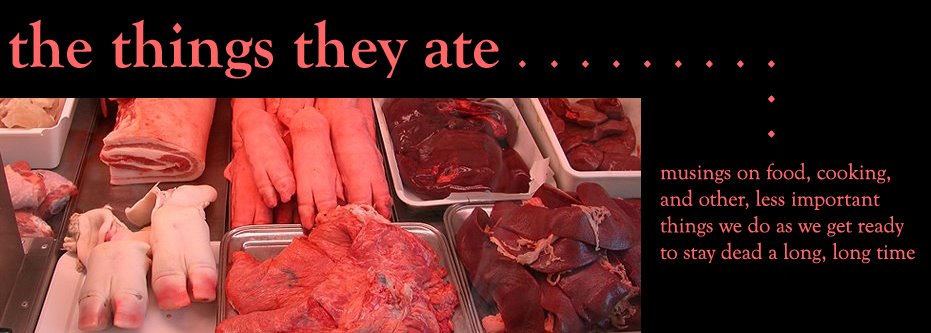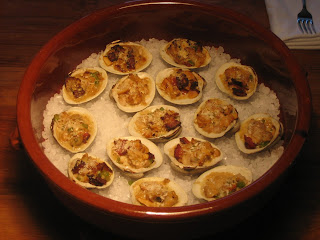I have mixed feelings about Marcella Hazan. Does that make me bad?
One the one hand, I feel tremendously grateful toward her. She has, through her books, taught me a great deal about food--particularly about how to pull ever-greater degrees of flavor from a basic palate of ingredients through patient and careful cooking. I also admire her crotchety, no-bullshit personality. Anyone who insists on whiskey and Marlboros while the effete foodie pretenders around her are swirling their Barolos and nibbling on grisini--well, she's okay in my book. Add to that the fact that she's Venetian, or a least lived in Venice for a long time (which is, despite all of its eccentricities and shortcomings, is the best city in the world), and the fact that she still apparently makes fresh pasta even with one of her hands gnarled into a claw, and you have someone who I would very much like to get drunk with.
So what's not to love? Weirdly, my ambivalence for Mrs. Hazan all began with a conversation I had about, oh, ten years ago with an acquaintance who cooked professionally. I had read Hazan's
Marcella Cucina not to long before this conversation. This must have been about 1997 or 98, when every restaurant in creation was abandoning butter with the bread service and switching to olive oil. At some point in the book, Hazan goes on a diatribe against the practice of both eating bread before a meal and dipping it in olive oil. I forget, now, what her exact criticism of the practice was, although I'm pretty sure that it had to do with the Italian custom of serving bread mainly with meat dishes (to sop up juices) and with her sense that using bread to sponge up as much olive oil as possible was a little mental. Eitherway, this fellow was running a restaurant (badly) at the time, and he followed
la mode by putting out cruets of cheap, grean XVO with his plates of baguette.
Being something of a contrarian (read: asshole) by constitution, I said to him, "Nah, nah, nah. Marcella Hazan says it's stupid to serve olive oil with bread!"
To which he retorted (for he had a flair for rhetoric): "Marcella Hazan is a fat parrot!"
Frankly, I was stunned.
I don't think I had ever heard someone called a fat parrot before. It created a strange and lingering image in my mind. Prior to this moment, Hazan had had her own special cloud in my personal culinary heaven. She was up there with James Beard and Julia Child, with Alain Senderens and Pierre Franey. She would have been up there with Jeff Smith, too, I suppose, but in my vision of gastronomic Shangrila, Smith is always off somewhere, raping a boy. Ouch! Okay, okay. That was never established in a court of law, perhaps because the best-selling cookbook author of all time had more than enough scratch to keep people quiet. Anyway, I frankly find it very easy to separate whatever may have been his personal, uh, eccentricities from the indisputable fact that he as a damned fine culinary teacher...
...although that calls for a digression. When PBS was airing the TV episodes related to
The Frugal Gourmet Cooks Three Ancient Cuisines, Smith went on location to Hong Kong, where he had a discussion with someone who was, I suppose, an authority on Chinese cooking. The two of them got to talking about the whole chopsticks-fork thing. The Chinese guy observed that his native cuisine was "more sophisticated" that the barbarian food of the West because all of his culture's cooking was done in the kitchen, leaving the diner to do minimal work at the table, allowing the diner, in fact, the luxury of being able to eat with a couple of sticks rather than a miniature version of a hay-baling tool. Now this is all fine and well. I have no personal devotion to the knife and fork, and I enjoy eating with chopstick very much. I just happen to be something of a fan of Western civilization, and I would like to think that the fact that we can appreciate a nice roast doesn't make us knuckle-dragging gibbons.
I'm rather proud to report that my recipe for ragu is pretty darned close to Hazan's.
 A Meat Sauce in the Style of Bologna (Ragu)
A Meat Sauce in the Style of Bologna (Ragu)1 bottle cheap-ass red wine
2 T. extra virgin olive oil (or any other oil you have lying around)
2 medium yellow onions, chopped
4 small carrots, peeled and chopped (I really think organic carrots are worth the money)
2 ribs celery, chopped
1 head garlic, peeled, smashed and chopped (about 15 cloves)
3 lbs. grass-fed beef chuck or rump roast, diced
2 28oz. cans diced tomatoes (I used Muir Glen)
1 T. dried Mediterranean oregano (make sure it's not Mexican, which is WAY different)
1 T. dried thyme
1 T. sweet paprika
1/2 T. red chili flake
a decent grating of nutmeg (you should be working from whole nutmegs)
water
1/2 pint heavy cream
salt and pepper
Empty the entire contents of the wine bottle into a small saucepan. Set over high heat and boil vigorously for at least ten minutes. This is a critical step, and one which I now follow whenever I'm cooking with wine. I'm damned if I can remember where I read or heard this (I'm thinking it was either Alton Brown or Thomas Keller), but I makes a huge difference to the finished flavor, eliminating the harsh alcoholic notes that never seem to cook off. You'll note this in braised beef and steamed mussels immediately. The harshness of the wine might be less noticeable in a complex dish like this one, but you can still tell.
Heat the oil in a convenient pan. Cook the onion, carrots, celery, and garlic until everything is soft, but don't let the mixture take on any color. When it's done, remove from the pan and set aside.
Turn heat up to high. Put a touch more oil into the pan, and then add the beef a little at a time (to avoid overcrowding and, thus, steaming rather than browning the beef--which is your goal here. Why brown the beef and not the aromatic vegetables? There's a good deal more, well, substance to the meat. It takes well to browning, whereas the vegetables just seem to break down into bitter goo if you let them color. (Even French onion soup needs to be brown very slowly if it's to taste rich and sweet.) If you start with a big enough pan, you should be able to just push the first few installments of beef to one side to accomodate the remainder of your meat. If not, you can pull it from the pan to make more room.
When the beef has a decent color, add back the aromatic vegetables and all of the other ingredients except the heavy cream. You your judgment on the water. You my need a little or a lot, depending on how far you reduced your wine and how much water was in your can of tomatoes. The consistency should be like, what? Chowder? The goal is to keep everything fluid during the simmer yet still end up with something the consistency of sauce rather than soup. The mixture will thicken as it cooks through evaporation. You need a little finesse here to get it right.
That's pretty much it. Let it cook for as much time as you have. Three hours is probably the dead minimum; twelve would certainly not be too much. Ideally, the meat will fall apart and be assumed into the body of the sauce. Ahh! That's ragu! About twenty minutes before you serve, stir in the heavy cream. This gilds the lily, making something already rich and unctuous richer and unctuouser. Correct the seasoning, and you're good to go.
Oh, and it really taste a lot better if you let it cool completely overnight and then reheat it the next day. You'll need to correct the seasonings, of course.
Ragu is a real multipurpose material. On the first night (if you can't wait for the ideal second-night first serving) is terrific over fresh pasta (medium-wide noodles, like tagliatelle.) Grace the dish with some grated Pecorino or Parmesan and a few dried chille flakes. The next night, the congealed leftovers can be tucked into balls of cold risotto and fried as arancini. You can thin the stuff into a passable soup or use it full strength as a bruschetta topping, kind of an Emilia-Romagna sloppy joe.












